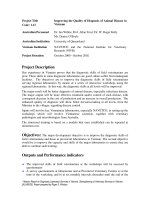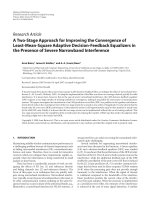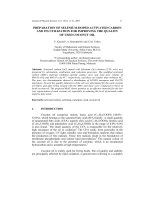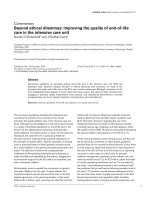management innovations for improving the quality of education in ha noi
Bạn đang xem bản rút gọn của tài liệu. Xem và tải ngay bản đầy đủ của tài liệu tại đây (1.29 MB, 117 trang )
SOUTHERN LUZONSTATEUNIVERSITY, LUCBAN, QUEZON, PHILIPPINES
IN COLLABORATION WITH
THAINGUYENUNIVERSITY, SOCIALISTREPUBLIC OF VIETNAM
__________________________________________________________________________
MANAGEMENT INNOVATIONS TOWARDS
IMPROVING THE QUALITY OF
EDUCATION IN HANOI
DOCTOR
OF BUSINESS ADMINISTRATION
BY
Le Ngoc Quang– Lanos
August 2013
ACKNOWLEDGEMENT
In order to complete this dissertation, I need helps from many people. Their helps
provided the very great contribution to my work. I am deeply indebted to all of them.
First of all, I wish to thank Dr. Edwin P. Bernal, my advisor. Without his very useful
help and advice I would not be able to finish my work. His very high requirements have
encouraged me to try my best.
I also want to thank all my professors and staffs of SOUTHERN LUZON STATE
UNIVERSITY and THAI NGUYEN UNIVERSITY for their interesting lectures and help
which provided me necessary knowledge to write this dissertation, as well as to work for
my future.
In order to have a good dissertation with scientific quality and practical significance,
I need to collect some information from the principals and teachers of schools in Hanoi
City. Without their very useful ideas and information, my dissertation can not be
completed. I want to give my sincere thanks to them for their valuable cooperation and
kind help.
I would like to thank Hanoi Education and Training Department, People’s Committee
of Dong Anh District and all commentators who shared me their time, and encouraged me
to tmake my dissertation better.
I need to express my special thanks from the bottom of my heart to my parents who
brought me into the world and brought me up. Also, I am indebted to all members of my
family, who kept encouraging and providing me with great favors when I was taking this
course.
I am grateful to all my classmates and my friends who helped me to collect materials
in the preparation of the dissertation. Their assistance helped me to save my limited time
to focus in writing.
Lastly, I am indebted to many other people. They are writers of useful materials in
books, internet, and newspapers.
TABLE OF CONTENTS
CHAPTER I INTRODUCTION 5
I. Background of the study 5
II. Statement of Research Objectives 6
III. Statement of the Problem 7
IV. Significance of the Study 8
V. Scope and Limitations of the Study 10
VI. Operational Definition of Terms 11
CHAPTER II REVIEW OF RELATED LITERATURES AND STUDIES 13
I. Related Literature 13
1. The Vietnamese Educational System in a Nutshell 14
2. Some Practices in Educational Management in Other Countries 16
3. Some Local Initiatives Toward Improving Quality of Education in Vietnam 21
4. Training standards and post graduate degrees for university lecturers and
college lecturers by 2020. 23
II. Related Studies 25
III. Theoretical Framework 29
IV. Conceptual Framework 34
CHAPTER III RESEARCH METHODOLOGY 37
I. Locale of the Study 37
II. Research Design 37
III. Population, Sample and Sampling Technique 38
IV. Research Instrument 39
V. Data Gathering Procedure 39
VI. Statistical Treatment 40
CHAPTER IV RESULTS AND DISCUSSIONS 41
I. The Human Capital & Material Resources 41
II. Responsiveness of Selected School Management Inputs 60
CHAPTER V SUMMARYOF FINDINGS, CONCLUSION AND
RECOMMENDATIONS 82
III. SUMMARY OF FINDINGS 83
Faculty complement. When compared to the students’ enrolment in various
grades, the faculty complement does not match the actual requirements for
ensuring quality education. Considering that teacher-student ratio is as high as
1:75 particularly in urban centers, there is much to be desired in coping up with
the number of school teachers in Vietnam. 83
IV. CONSLUSION 87
V. RECOMMENDATIONS 87
BIBLIOGRAPHY 92
APPENDIX 94
LIST OF TABLES
Table 1 General Information on Survey Respondents 42
Table 2. Respondents Classified By Type and Grade of Schools 43
Table 3. School Managers’ and Teachers’ Training Standard and Capability to Use
Foreign Language and Information Technology (IT) 48
Table 4. Enrolment in Hanoi in School Year 2012-2013 52
Table 5. Students’ Performance in National High School Exit Examinations 53
Table 6. Performance of Hanoi-based Schools in the National University Entrance
Examinations 54
Table 7. Distribution of Schools in Hanoi as of School Year 2012-2013 56
Table 8. Frequency Distribution of Electronic Instructional Materials as of SY 2012-
2013 59
Table 9. Frequency Table on the Degree of Compliance to Assigned Tasks (N=169) 61
Table 10. Difficulties Faced by Public Schools in Relation to Financial Sources 66
Table 11. Assessment Ratings by Managers and Teachers on Training Curricula 68
Table 12. Assessment Ratings by Managers and Teachers on Training Curricula
Classified by Grade of Schools (%) 69
Table 13. Proposed Solutions for Developing High-Quality Educational Services in
Hanoi 71
Table 14. Proposed Solutions For Managing Responsive Educational Services (%) 73
Table 15. Solutions For Ensuring Equality Between Public And Non-Public Schools 74
Table 16. Proposed solutions for improving training quality of foreign languages and
informatics in hanoi 79
Table 17. General Solutions for Improving Educational Quality in Hanoi 80
LIST OF FIGURES
Figure 1. Vietnam Education and Training System 15
Figure 2. GMR2005 Framework for Understanding Education Quality 29
Figure 3. Overview of the Process of Developing Improvement Actions 31
LIST OF CHARTS
Chart 1. Faculty Trend in Hanoi Schools from SY 2000-2001 to SY 2009-2010 45
Chart 2 Education Centers Meeting MET Standards as of May 20, 2013 55
Chart 3. Opinions of Managers About the Inadequacy of Existing Mechanisms for
Assigning Tasks to Public Schools 62
Chart 4. Proposed Solutions For Promoting International Integration In Education In
Hanoi (%) 78
5
CHAPTER I
INTRODUCTION
I. Background of the study
According to the International Organization for Standardization (ISO 9000),
the product quality is measured by the degree of conformance to the collection of
characteristics of predetermined specifications and standards. The quality of products
and services create a trademark, prestige and the existence of an organization in
current circumstances.
On one hand, the Department of Education Standard School-Ministry of
Education and Training 2010 posit that quality education can make progress. The
capability of the students to access and gain new knowledge is seen as a step towards
advancing in life. Achieving quality education, therefore, must be taken seriously.
However, given the limitations, the desired quality of education has not yet been
coming as expected.
The Hanoi 2020 Vision 2030 approved by the City People's Committee in July
2012 defined quality education and training comprehensively. Accordingly, in 10
years, the education and training sector should have strived and achieved good results
in expanding access to opportunities; developed a wide range of school types and
forms of learning; implemented innovative education and improved the quality of
staff; the education law and the traditional education are enhanced; the solidification
program, school modernization investment priority, and the number of schools
increased rapidly to national standards; the management of education system has had
significant innovations in the direction of increased decentralization, autonomy and
social responsibility in performing the assigned tasks, organizational structure,
staffing and in financing of public schools; and, the models of private schools and
6
other educational institutions have elements coming from or influenced by best
practices from foreign countries which were gradually put into effective operation,
and at the same time attracting resources for social investment to education and
training for sustainable development.
The motto of educational development is “standardization, socialization,
modernization and democratization.” Hanoi capital which is the center of politics,
science and economy of the country needed to respond aggressively to the aims of this
educational development. Therefore, improving the quality of education should
become a very urgent concern in order to create a workforce with the necessary
knowledge, skills and attitude required at meeting the requirements of socio-economic
development in the Hanoi capital.
However, the education system is without any pressing issues and concerns. It
is still far from responding very effectively and efficiently to the call of times. In
particular, the quality of education in Vietnam is still generally wanting. It is in this
context that this research project was conducted.
II. Statement of Research Objectives
With the end-goal of improving the quality of education, this research focused
on the following specific objectives:
a. To describe the condition of human capital and material resources in
Hanoi-based schools in terms of professional qualifications of school
managers and faculty, faculty complement, prevalent human resource
management practices, school managers’ and teachers’ training standard
and capability to use foreign language and information technology,
7
student enrolment, students’ performance evaluation, school distribution
in Hanoi, education socialization; and library and other learning facilities.
b. To obtain from the research respondents and describe their perception on
the responsiveness of the selected school management inputs such as
assigned tasks, financial system, and school curricula, in responding to
the need of effectively managing the educational system.
c. To describe the respondents’ desired improvements for an effective
management of educational system towards achieving responsiveness in
educational services, equality between public and non-public schools,
comprehensive international integration, and improved quality of training
in foreign languages and informatics.
III. Statement of the Problem
This research was conducted to look into some possible management
innovations for the purpose of improving the quality of education in Hanoi.
Specifically, this research work was designed to answer the following problems:
a. What is the condition of human capital and material resources in Hanoi-
based schools in terms of:
- Professional qualifications school managers and faculty;
- Faculty complement;
- Prevalent human resource management practices;
- School managers’ and teachers’ training standard and capability to use fore
ign language and information technology;
- Student enrolment;
- Students’ performance evaluation;
8
- School distribution in Hanoi;
- Education socialization; and
- Library and other learning facilities.
b. How responsive are the selected school management inputs such as assigned
tasks, financial system, and school curricula in responding to the need of effe
ctively managing the educational system?
c. What improvements can be proposed for an effective management of educati
onal system towards achieving:
- Responsiveness in educational services,
- Equality between public and non-public schools,
- Comprehensive international integration, and
- Improved quality of training in foreign languages and informatics.
IV. Significance of the Study
This research work will be very significant to the following:
a. For the Department of Education and Training Hanoi People's Committee of
Hanoi City, People's Committees of districts, Education and Training, this
research can be a valuable inputs in formulating their plans and strategies in
improving education and training in Hanoi.
b. For students and future researchers, this study can provide an array of rich
data useful for understanding the status and the problems being faced by the
education managers in Hanoi. Further, this can serve as a ready reference
towards deeper study of the other issues and the corresponding
improvements that the educational system needs to undertake in the future.
9
c. For students, this research is very important as it is hoped that this will result
in improvements in school management. The old management system will be
replaced by the new ones. The refinements in teaching and in education will
allow educational institutions to come closer to the educational mission of
the century - learn to know, learn to work, learn to live, and learn to express
yourself. The students are expected to be able to acquire knowledge, skilla
and attitude to become honest, responsible, empathic, optimistic, active, and
creative citizens.
d. For the students’ parents, this research will help them to have the most
realistic view toward educational quality. As a result, they will be expected
to make intelligent choices for their kids’ learning environment. At the same
time, they can help create the best educational environment at home. They
will be given the opportunity to react positively and co-operate with the
schools in educating their children.
e. For managers in Hanoi, this research is will be meaningful to them as they
will be able to see their weaknesses and expected to institute suitable changes
for the education sector.
f. For teachers, this research will help them work on changing the content and
methods of education. The parents also recommended investing in teaching
conditions and educational methods for their children.
g. For potential investors in the education sector, including the government,
businesses, private companies, etc., this research will serve as a source of
good reference especially for those who aspire to create innovative
educational environment. For foreign and domestic investors who spend
money on non-public schools, they will have good references on the
10
government’s policies and have necessary recommendations and decisions
when investing.
V. Scope and Limitations of the Study
This study covered the primary schools, middle schools, and high schools
in both the private and public sectors which are under the jurisdiction of the
Hanoi Department of Education and Training. Particularly, the research work
delved into the human capital and material resources, responsiveness of the
selected school management inputs, and the possible improvements in the
management of education system in Hanoi, Vietnam. The data used to analyze
the situation in the educational system of Hanoi were taken from available
documents from 2003 to 2012, while the primary data were gathered from
teachers and school managers from the aforementioned schools.
While the respondent-teachers and school managers have countless
innovative ideas on how to improve the quality of education in Hanoi, the
domestic policy and the political institutions are some concerns beyond the
control of the researcher, hence these are considered research limitations. In
addition, the economic downturn in Vietnam led to social security problems,
hence investment in development programs including infrastructures in
educational sector had become limited. Therefore, this may have a serious effect
on the respondents’ perception on the quality of education in Hanoi which was
not statistically measured.
11
VI. Operational Definition of Terms
The following terms were defined on the bases of how they were used in
this study:
a. Management innovations refer to the creation of policies and
mechanisms in management so that the quality of educational services is
improved.
b. Quality of education refers to the value of conversion. A quality
education is an education that effect positive changes on the students
coming from the public and private educational institutions offering
primary, middle, and high school education under the jurisdiction of the
Hanoi Department of Education and Training.
c. Responsiveness of school management inputs refers to the expected
effect of the assigned tasks, the financial system, and the school curricula
on the management of educational institutions in Hanoi.
d. Comprehensive international integration refers to the ability of the
educational system in Hanoi to enhance the quality of education by
bringing the factors contributory to excellent education, i.e., school
curricula, management system, and school facilities and physical
equipments, are at par with the international standards thereby making the
graduates in primary, middle and high schools ready to face the rigors of
college education which prepares students to become competitive locally
and globally.
e. Education socialization refers to the method used to gain essential
purposes of education where the government, in all cases, always takes
responsibility, and doesn’t entrust to others. According to resolution 05 of
12
the government (18
th
April, 2005), the government is committed to
increasing socialization of the educational, medical, cultural and sports
activities. In particular, for the education and training, the government is
expected to continue increasing investment budget for the education and
training; channel resources of departments, levels, business and social
organizations and individuals to develop education and training; innovate
on the activities of the public schools and the school fee systems; and
enhance the non-public schools.
13
CHAPTER II
REVIEW OF RELATED LITERATURES AND STUDIES
This chapter presents the related literature and studies reviewed by the researcher
from the world wide web, journals and various libraries in the hope of having the study
yield better results. The discussion of related literature brings into light what educational
management and quality education are all about both in global arena and in Vietnam. On
the other hand the review of related studies distinguishes different studies undertaken by a
number of research projects on the relevant variables in this research. This chapter also
presents the theoretical framework, and the conceptual framework.
I. Related Literature
It is an undeniable fact that, in general, education is a vital mover of the economy.
Needless to say the need to imbibe a culture and mindset of quality education is an
undertaking that every nation should strive to embrace, attain and eventually benefit from.
To date, however, while, programs and serious initiatives both by the national and the
local governments had been undertaken, quality of education in Vietnam is still wanting.
This part of the study will present literatures, articles and writings that will tell
the story of how education has become what it is today. As in any case, a means to
understand something is to understand its beginnings. Initially a history of the origins of
Vietnamese educational system is presented. The discussion proceeded by highlighting
the practices and experiences from other countries, including the Philippines, from which
lessons may be learned. Finally, the current and proposed educational programs of the
country are discussed in order to offer readers with some basis for understanding where
the Vietnamese education is heading to.
14
1. The Vietnamese Educational System in a Nutshell
The pre-school takes care of the raising, caring and educating children from three
months to six years of age. The primary education takes a five year duration grade one
up to grade five. The average age of students in grade one is six.
The secondary education is completed in four-year time from grade six to grade
nine. The student finishes primary education at the age of eleven. The high school lasts
in three years, from grade ten to grade twelve. Students attending grade ten must have
the certificate of graduation from secondary school at the age of fifteen.
The vocational education has vocational secondary school and vocational school
(primary, secondary, and college). Meanwhile, the professional intermediate may be
completed within three to five years of learning for people with secondary school
certificate, and within one to two years of learning for people with high school
certificate.
Career development maybe completed within one year for beginner level, and
from one to three years for intermediate and upper levels. The tertiary and post-graduate
education trains college level, graduate level, master level, and doctor level.
Tertiary education. The college education has a duration of two to three years
depending on majors for people with high school or vocational secondary school
certificate; from one year and a half to two years for people with vocational school
certificate of the same majors. The undergraduate education is completed from four to six
years depending on majors for people with high school or vocational school certificate;
from two years and a half to four years for people with vocational school certificate of the
same major; from one year and a half to two years for people with college certificate of
the same major. The master education takes from one to two years for people with
15
undergraduate degrees. The doctor education takes place within four years for people
with undergraduate degrees, from two to three years for people with master degrees. In
special occasions, the duration of doctor education can be extended depending on the
decision of the Education and Training Department.
Figure 1. Vietnam Education and Training System
(According to educational laws 2005)
Currently, Vietnam have some 3 million university and college students. Nearly 15 m
Post-graduate
Doctor
Master
Tertiary education
Undergraduate
Diploma
Vocational
secondary school
Vocational
education
College
Secondary
Primary
General education
High school
Secondary school
Primary school
Pre-school
16
illion students (14,762,961) are in the primary, secondary and high school levels, and near
ly 4 million (3,873,445) children are enrolled in the kindergarten level. On the one hand t
here are about 84,000 teachers in various universities and colleges. 1,670,000 teachers are
in the primary, secondary and high schools.
There are about 400 universities and colleges, 15,400 primary schools, 10,600 secondary
schools, and 2,350 high schools. Other educational facilities such as kindergartens,
regular education, and community learning centers add up to 13,500.
2. Some Practices in Educational Management in Other Countries
William R. Tracey (2003), in The Human Resources Glossary defines Human Resour
ces as "the people that staff and operate an organization … as contrasted with the financia
l and material resources of an organization. The organizational function that deals with th
e people, " human resources evolved from personnel management as the field moved be
yond paying employees and managing employee benefits. The evolution made verbal the
fact that people are an organization's most important resource. People are assets that must
be hired, satisfied, developed, and retained.
Recent evidence of a substantial link between quality of schooling and individual pro
ductivity suggests that, from an economic efficiency perspective, the quality aspects of ed
ucation deserve attention. The paper entitled Private and Public Schooling: The Indian Ex
perience by Geeta Gandhi Kingdom- of the University of Oxford (2005) presented empiri
cal evidences on the relative quality and efficiency of private and government-funded sch
ools in urban India, using data from Uttar Pradesh. The results suggested that standardizin
g for home background and controlling for sample selectivity greatly reduced the raw ave
rage achievement advantage of private school students over public school students, but di
d not wipe it out. Private schools' standardized achievement advantage (or better quality)
17
was complemented by their lower unit costs to enable them to be more efficient. The resul
ts supported much of the existing international evidence on the relative efficiency of priva
te and public schools.
Meanwhile, the role of improved schooling, a central part of most development strate
gies, has become controversial because expansion of school attainment has not guarantee
d improved economic conditions. Eric A. Hanushek and Ludger Woessmann (2008) revie
wed the role of education in promoting economic well-being, focusing on the role of educ
ational quality. It concluded that there was a strong evidence that the cognitive skills of th
e population - rather than mere school attainment - were powerfully related to individual e
arnings, to the distribution of income, and to economic growth. New empirical results sho
wed the importance of both minimal and high-level skills, the complementarity of skills a
nd the quality of economic institutions, and the robustness of the relationship between skil
ls and growth. International comparisons incorporating expanded data on cognitive skills
reveal much larger skill deficits in developing countries than generally derived from just s
chool enrollment and attainment. The magnitude of change needed makes it clear that clo
sing the economic gap with industrial countries will require major structural changes in e
ducational institutions.
The developing countries in Asia need to improve the quality of their education syste
ms as many graduates lack the skills needed in today's rapidly changing workplace, accor
ding to the Asian Development Bank as reported by the China View. The ADB Vice Presi
dent Ursula Schaefer-Preuss said that the shortage of skilled workforce in the Asia-Pacific
region, male and even more so female, has been a major bottleneck in economic and socia
l development (Yan Liang, (2008).
In a report in the Education and Skills: Strategies for Accelerated Development in
Asia and the Pacific, it was emphasized that the demand for higher education is booming
18
and is expected to double in five years and triple in 10 years in many of ADB's
developing member countries. However, the report cautioned that the targeted expansion
will continue to be haphazard because of the many institutions of inferior quality. (Asian
Development Bank, 2008).
It may be worthy to note that the Philippines has a decentralized public education
system that provides free primary and secondary education. Primary education, normally
for pupils aging between 7 and 12 years old is compulsory. Its education budget is about
17% of the national budget. The literacy rate in the Philippines is 94.6%. (Human Resour
ces Development Working Group
Accordingly, the general goals of education in the Philippines are to (1) provide a
well-rounded education that will assist each individual in society to attain his or her
potential as a human being, and enhance the range and quality of the individuals within
the group; (2) help the individual to participate in the basic functions of society and
acquire the essential educational foundation for his or her development into a productive
and versatile citizen; (3) train the nation's manpower in the middle-level skills required
for national development; (4) develop high-level professionals that will provide
leadership for the nation, advance knowledge through research, and apply new knowledge
for improving the quality of life; (5) respond effectively to changing needs and conditions
through system of educational planning.
Over the years, the Philippine educational system had continuously placed greater
emphasis on English, science, technology, mathematics and staff training for
administrators. Vocational education has also been revised to incorporate technological
advancements. Strategies for active improvement of education have included curriculum
development, improvement of private and public school teacher education prior to their
careers as well as during, update of materials and equipment, improving access of
19
disadvantaged students, liberalizing policies for higher education private schools, and
strengthening connections between government professional boards for evaluation.
The more notable programs aimed at improving education in the Philippines are:
(1) The Elementary and Secondary Education Project. The aim of the project has been
to meet the sector's requirement for essential physical resources (facilities and
equipment), especially in educationally and economically disadvantaged areas; improve
the professional competence of teachers and school administrators; expand the
population's basic knowledge and the skills of children at risk of dropping out of school
as well as illiterate out-of-school youth and adults. As well as further development of
Department of Education institutional capacities in planning and management of the
education system; (2) Implementing the New Secondary Education Curriculum
(1992-93). This project had implemented a mass training for Grade 4 teachers which was
complemented with the production and delivery of textbooks and teacher's manuals to
fully support the implementation of the new curriculum; (3) National Early Childhood
Care and Development (ECCD) System for Pre-School Education. It refers to the full
range of health, nutrition, early education and social services programs that provide for
the basic holistic needs of young children from birth to age six (6), to promote their
optimum growth and development. It aims to facilitate smooth transition from care and
education provided at home to community or school-based setting and to ensure that
young children are adequately prepared for the formal learning system both in public and
private schools; (4) The School Building Program. This program provides for the
construction of classrooms, science laboratories and multi-purpose workshops, and the
provision of equipment for instruction for selected elementary and secondary schools
within the typhoon belt of the country and in remote or rural areas; (5) Science Teaching
Improvement Project. This project aims to develop science equipment through research,
20
prototype production, standards setting and tests, and expertise within the educational
sector through workshops seminars, and training of teachers and staff locally; (6) Science
Equipment Project. This project addresses the pressing need of the public school system
for instructional materials and equipment. The National Science Equipment Center and
three Regional Distribution/ Service Centers were developed and institutionalized for the
purpose of developing, testing, producing, and distributing science equipment to the
public secondary schools; (7) Rationalizing Program offerings of State Colleges and
Universities on a regional basis. This program encourages specialization in each State
College and University (SUCs) and intra-regionally among SUCs with special emphasis
on capital and land-intensive courses such as agriculture, technology, engineering, and
technical education. The program encourages regional coordination among SUCs to
minimize duplication of program offerings.
The latest in the Philippine education is the implementation of the K + 12 Program
requiring a compulsory attendance to a Kindergarten school by a child before he or she
can be admitted to Grade 1 in primary school. In addition, two (2) senior years in high
school has been added. All in all, a student must take a compulsory Kindergarten school
plus twelve years in basic education (elementary and high school) before he or she can be
admitted to college. All of these are generally intended to make students more learned
individuals and competitive professionals in a global setting.
Pre-school and Elementary education. Pre-school education is compulsory and
includes nursery schooling and kindergartens that cater to children three to six years of
age. Elementary school is compulsory and provides students seven to twelve with six
years of schooling. These six years are divided into primary and intermediate. Primary
level covers grades one to four while intermediate is for grades five to six or seven.
Students receive a certificate of graduation following completion of Elementary school.
21
Secondary education. Secondary education (high school) continues elementary
basic education and includes vocation and technical education. Secondary education is
designed for students age 13-16 and includes four years of instruction. Again, with the
introduction of the K + 12 Program in the Philippines, the 4 years of secondary education
has been extended to six to include two additional senior years.
Higher education. Higher education can include a two-year post-secondary
programs that trains students for a career in technology or vocation. Other students may
choose to study for a professional career at a four-year university or state college in order
to obtain their baccalaureate degree. Further, graduate students are eligible for an
additional two to three more years of studying to complete their graduate degrees. Post-
graduate degrees (doctoral) may take another two to three years to complete.
3. Some Local Initiatives Toward Improving Quality of Education in Vietnam
The Prime Minister has approved the "Strategy for Education Development 2011-
2020.” The strategy is directed at achieving standardization, modernization, socialization,
democratization and integration of international education quality in education. It is
envisioned, by 2020, 25% of university lecturers and 8% of college lecturers must have
earned doctoral degrees. The strategy stated that standardization in training, selection,
usage and evaluation of teachers and education managers, focusing on improving
professional ethics, manners and behavior of teachers and to make models for students.
The strategy aims for institutionalizing the periodic evaluation of the quality of
student learnings. By 2020, it is expected that 90% of primary schools and 50% of
secondary school teaching are holding two sessions per day. Renewal exams, high school
and college entrance exams shall be efficiently put in place towards ensuring practical,
efficient, impartial and test results.
22
The development plan of Education - Hanoi Training 2020 Vision 2030
encompasses all grade levels from preschool to upper secondary and professional
secondary schools under the jurisdiction of Department of Education and Training
(excluding Vocational), for both public and non-public schools. The proposed
development plan adopts a strategic direction and implementation of planning solutions
based on practical economic development - education and social capital.
With the objective of contributing to the development of education and training to
improve people's knowledge, personnel training and the fostering of talents to meet the
requirements of industrialization and modernization of the country, the Hanoi 2020,
Vision 2030 has planned for setting up school network for the area.
Specifically the notable strategies follow:
Social supervision over the quality and efficiency of education.
One of the innovations in management education is to ensure democratization of
education. The implementation of mechanisms involved is in the area of evaluation of
school teachers. In addition, the mechanics for classifications of quality education
covering vocational education and higher education shall be done according to the quality
standards of national education. At the same time, focus shall be made on the
development of advanced educational institutions towards developing highly competent
human resources for the society. In general, the program shall focus on quality
management education, social supervision over the quality and efficiency of education,
build an independent testing system for quality education, and implement the quality
inspection of institutions in all educational levels. (The Prime Minister-the "Strategy for
Education Development 2011-2020.")
23
4. Training standards and post graduate degrees for university lecturers and
college lecturers by 2020.
The strategy provided that standardization in training, selection, usage and
evaluation of teachers and education managers shall focus on improving professional
ethics, manners and behavior of teachers to make them models for their students. The
continuing training and retraining of teachers until 2020 expect that 100% of preschool
teachers should have achieved senior level training standards, 88% of secondary school
teachers and 16.6% high school teachers meet the standard level of training; 38.5% of
professional secondary teachers, 60% of college lecturers and 100% of university
lecturers achieved master's degree or even higher, and 100% of university and college
lecturers use foreign language fluently. The implementation of the project assume that the
trainers are qualified faculty for universities and colleges, and 25% of university lecturers
and 8% of college lecturers are PhD holders (The Prime Minister-the "Strategy for
Education Development 2011-2020").
Reform programs and textbooks after 2015. Based on evaluation of general
education and with reference to current program of advanced countries, implementing
innovative programs for textbooks until 2015 will improve student capability for learning
althroughout the country. The program focuses on moral content of education, law,
physical defense - security and cultural values of traditional life skills education, labor
education and vocational education. This will also focus on continued innovation of
teaching methods and learning outcomes assessment, training towards promoting
positive, self-discipline, initiative, creativity and self-learning capacity of learners. (The
Prime Minister-the "Strategy for Education Development 2011-2020").
Periodic evaluation of the quality of student learning. By 2020, 90% of
primary schools and 50% of secondary schools will be able to hold two sessions per day.
24
Renewal exams, high school, and college entrance exam shall be conducted towards
ensuring practical, efficient, impartial and fair test results.
Notably, the innovation in education is basically directed towards standardization,
modernization, socialization and international integration. The development of
educational systems and training in Hanoi became the center of education and training of
high quality leaders in the country. Teaching staff, and school managers are expected to
lead in creating and implementing innovative programs and teaching methods. They are
expected to ensure that teaching conditions are appropriate to improve the quality of
education in the direction of national standards, regional and international levels. Some of
the expected outcomes in each grade levels are:
Primary Education. Each commune, ward, town and new urban area should have
at least ten public elementary schools. Encourage the development of model schools
(public and non public) that provide high quality services. Expectedly, 100% of primary
schools have separate facilities. 70% to 80% of primary schools are at par with the
national standards by 2020. 90% of school conduct sessions twice a day in 2015, and
100% of the students are having two sessions per day by 2020. Finally, the land area for
construction of new schools meets the standards prescribed by the State.
Secondary Education. Efforts shall be directed at maintaining the stability of the
universal secondary education by constantly improving the quality of education. Grade 9
students will gain Hanoi's standards as well as international standards especially the
proficiency in bilingual communications and basic science.
High School Education. The program shall ensure that all young individuals,
before entering life adulthood shall be ready to take on the role of responsible citizens
demonstrating capability for independent thinking, possession of cognitive skills and









